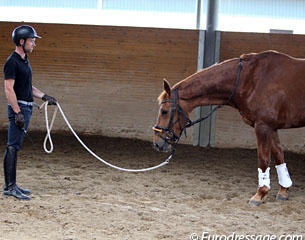
For 6-year old Fortuny and 4-year old Javeli parting from the nest and their horsey paradise here at home with me must have been a culture shock. Warwick McLean confirmed their good arrival at Stall Gehlenhof in Tönisvorst, Germany, the starting point of their dressage career. Firm proponents of good horsemanship, both Warwick and I believe that saddle breaking starts with proper ground work.
During their first two weeks at McLean Reitsport, the two girls were trained in-hand, initially on a rope halter, and after a while with a bridle on and the rope halter over it. It is remarkable to see how their characters come into play in their coping strategies with new surroundings, exposure to serious training, and learning material. Fortuny (by Furstenball x Grafenfels) has always been sugar and spice, sweet, kind, polite, even a bit shy to new things presented. Javelin (by Jazz x Grafenfels) has always been quite dominant, impatient, curious, sharp, and opinionated. At home she was not always the brightest cookie in the pack -- quickly getting tense and tight in new situations - but she was always very interested in what was being offered.. as long as it was to her liking. Jazz!
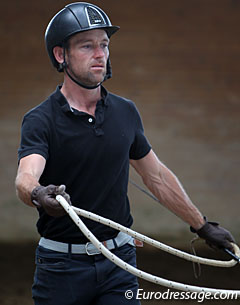 Warwick McLean and his assistant Johannes Rantner began by working the girls on the ground to gain control over the body and legs and teach them to fundamentals of pressure and release. One of the principal ground work movements they wanted both mares to understand was that they need to stand still and wait for their handler to give a command before they move again, no matter if the handler is standing at the saddle position next to the horse, in front of it, or further away holding it on a long lead rope.
Warwick McLean and his assistant Johannes Rantner began by working the girls on the ground to gain control over the body and legs and teach them to fundamentals of pressure and release. One of the principal ground work movements they wanted both mares to understand was that they need to stand still and wait for their handler to give a command before they move again, no matter if the handler is standing at the saddle position next to the horse, in front of it, or further away holding it on a long lead rope.
"Horses express fear by moving their legs," said Warwick. "To gain body and mental control, you need to immobilize those legs. It's a hardwired response to follow the leader (horse/human). But now we want them to stand still and teach them the command to go. They have to wait for you. They need to be taught the park response."
As horses are herd animals, they are used to living and standing close to one another in a group. Space invasion is typical for them but with humans they need to respect the handler's space and not run him over. Ground work is a perfect tool for that. Through pressure (by lightly tapping the whip on the horse) and release (by stopping the tapping and thus rewarding the horse for its response), you teach them to move their legs in the position you want.
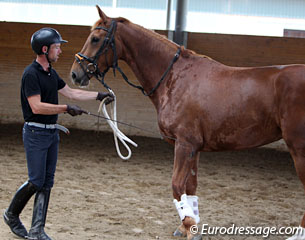 "The whip is an extension of the hand. You as handler need to keep your own position," said McLean. "They have to accept the whip in a neutral position on top of the body and not react to it. The whip is not to there to punish."
"The whip is an extension of the hand. You as handler need to keep your own position," said McLean. "They have to accept the whip in a neutral position on top of the body and not react to it. The whip is not to there to punish."
Patience is absolute key with proper ground work. "It is easy to step it up too much," Warwick warned. To start a young horse in a correct, psychologically non-demanding way, the handler can not lose his patience when the horse does not generate the wanted response. The contrast couldn't have been any bigger between the two girls: while Javelin was almost over eager and impatient - even angry - when she did not quickly get what was being asked, Fortuny remained stoic and was almost unresponsive to pressure. She stood still like a statue, distracted by her surroundings and with her head in the air. In the end Fortuny was quicker to understand what was being asked because of her easy-going attitude while Javelin needed more time to understand the task at hand. Still the chestnut's more sensitive reaction to pressure is promising for the future.
"To back a horse, you need to make it the least complicated for them and that is why we first do the ground work," said Warwick "You teach them step by step and make it all uncomplicated." When I asked if Fortuny's insensitive response is a disadvantage at this point, he replied that "lazy is even good. They have to accept contact."
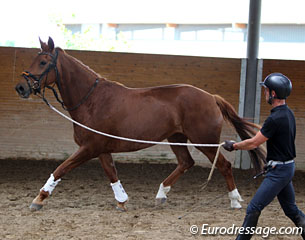 After doing some ground work where the handler moves the horse in the direction he wants, walks around the horse while it stands parked and relaxed, or moves close by and then away with the horse attentively watching the handler but standing still, Warwick began lunging Javelin on the lead rope in a small 10 meter circle. She was just doing a simple trot, not too forward and active, but a relaxed jog.
After doing some ground work where the handler moves the horse in the direction he wants, walks around the horse while it stands parked and relaxed, or moves close by and then away with the horse attentively watching the handler but standing still, Warwick began lunging Javelin on the lead rope in a small 10 meter circle. She was just doing a simple trot, not too forward and active, but a relaxed jog.
"Posture is so important for dressage, but for that phase you have to take your time to prepare them for it," said McLean. "First we just get them to trot on a circle and only then you slowly introduce a gentle side rein or the double lunge."
One of the posture positions Warwick also focuses on in the ground work is teaching the horse to drop its neck. By lightly tapping in the middle of the crest the horse will respond by dropping it. Releasing the pressure rewards the horse. The dropping of the neck is very good learned response to stressful situations in which the horse can find relaxation by going low, deep and stretched with the neck (no curling!)
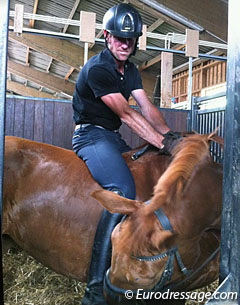 After a 20 minute session of ground work, Warwick took Javelin back to the stable and said the time had come to climb on top of her. McLean does not follow the strict traditional system of first lunging, then a girth, then a saddle and then a human on top. His process of "breaking a horse" is much more natural, less stressful, and more fun for both human and horse; exactly the reason why I chose him for my horses.
After a 20 minute session of ground work, Warwick took Javelin back to the stable and said the time had come to climb on top of her. McLean does not follow the strict traditional system of first lunging, then a girth, then a saddle and then a human on top. His process of "breaking a horse" is much more natural, less stressful, and more fun for both human and horse; exactly the reason why I chose him for my horses.
First Warwick just held Javelin on the rein and made her respond to the bit with pressure and release. "You can teach her a bit of contact just here in the box, in a relaxed atmosphere. The message has to go through the bridle and body. It's the beginning of posture control. You get her to react to the hand (by holding the rein or by giving pressure where the leg aid normally goes). We teach her rein back in the box."
Warwick first leaned on Javelin and then swung his leg over her and sat on top of her. I was in awe ! No bronco bucking, Javelin stood there relaxed, her back almost sagging. I remember each year when I put the fly blanket on her back for the first time she would throw a fit, terrified of having something new on her. Now Warwick was sitting there as if in an arm chair and Javelin was totally unfazed. He made her walk in small circles in the box with him on top and taught her to go forward to the inside leg.
"I prefer to get on the first time in the box, bare back. In the round pen there is too much distraction. In the box they need to focus on making turns in a small space,. This is much better than lunging them and putting side reins on, you make a much better connection between human and horse. With the saddle they are already constrained and you pressure them, to which they have to habituate. This leads to confusion."
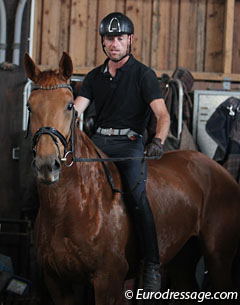 Warwick sat a few minutes on Javelin before he asked me to open the stable door and took her out into the corridor. The other horses had their heads out of the window and one of them tried sniffing Javelin's bum to which she gave the not so lady-like response of a sneaky, hard kick. Warwick joked, saying that "the Irish used to say that horses are less inclined to buck on concrete." Javelin easily coped with the first leg aids that drove her forwards in the corridor. She made her first stops and turns under saddle right there and then.
Warwick sat a few minutes on Javelin before he asked me to open the stable door and took her out into the corridor. The other horses had their heads out of the window and one of them tried sniffing Javelin's bum to which she gave the not so lady-like response of a sneaky, hard kick. Warwick joked, saying that "the Irish used to say that horses are less inclined to buck on concrete." Javelin easily coped with the first leg aids that drove her forwards in the corridor. She made her first stops and turns under saddle right there and then.
Johannes Rantner repeated the exact same ground work with Fortuny. "In the beginning it took an hour to teach them the first basics, but now, after two weeks, we can just check their responses," said Johannes. "It takes 15 minutes and then you can think about the next job."
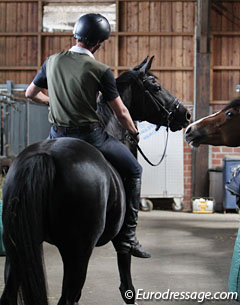 Fortuny had absolutely no problem with Johannes getting on her back in the stall. She was far less responsive to the leg aid and needed more encouragement and patience from the rider to make her walk in a circle in the stall. Also when she entered the corridor, Fortuny stood parked and did not move forward despite the leg aid. Johannes gave her rhythmic, incessant small kicks but did not lose his patience nor kicked harder because she did not react. As soon as she moved forward, he released the pressure with his leg and rewarded her with his voice.
Fortuny had absolutely no problem with Johannes getting on her back in the stall. She was far less responsive to the leg aid and needed more encouragement and patience from the rider to make her walk in a circle in the stall. Also when she entered the corridor, Fortuny stood parked and did not move forward despite the leg aid. Johannes gave her rhythmic, incessant small kicks but did not lose his patience nor kicked harder because she did not react. As soon as she moved forward, he released the pressure with his leg and rewarded her with his voice.
To see both my girls getting "ridden" for the first time was so impressive. It must have felt like a mom sending her child to school for the first time. Fortuny and Javelin have been my companions, cuddle bunnies and garden decoration for years but now they might actually become dressage horses! The road continues..
Text and Photos © Astrid Appels
Related Link
Part 1: Fortuny & Javelin Meet McLean: And So the Adventure Begins